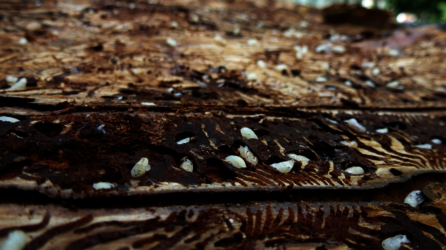Bark beetles can cause damage across extensive areas of coniferous forests. This changes the appearance of the forest landscape and has considerable ecological and economic consequences. Through intensive bark beetle monitoring with traps and designated “breeding observation trees”, we are able to maintain an up-to-date overview of the development phases of the beetles. These findings and the results of research projects flow into the day-to-day advice given to forest owners on the management of bark beetles in Baden-Württemberg. The main pests here are
- the European eight-toothed spruce bark beetle (Ips typographus),
- the smaller European six-toothed spruce bark beetle (Pityogenes chalcographus), and
- the silver fir bark beetle (Pityokteines curvidens).
The extent of damage to the forest, whether caused by bark beetles or by other harmful organisms, depends on changing environmental factors such as the climate. Rising temperatures generally favour the development of many harmful organisms. It is therefore important to identify and model important functional relationships between changing climate parameters and the development and extent of damage, so that we are better able to predict future developments.
One current focus of the department of Forest Protection is on the development and application of phenology and risk models for particularly harmful species. It is thus possible for example to determine the development status of the European spruce bark beetle and even the risk of infestation on a daily basis by modelling for any location (for the moment available in German only). This allows monitoring and management measures to be prioritised and adapted accordingly. Similarly, a phenology model for the oak processionary moth gives a spatially and temporally explicit indication of the optimum timing of control measures and the risk to the public from the insects’ stinging hairs.
Other exciting fields of work in the department include the remote sensing detection of forest damage, especially by bark beetles, as well as the much-discussed issue of forest protection in the buffer strips around the Black Forest National Park.
